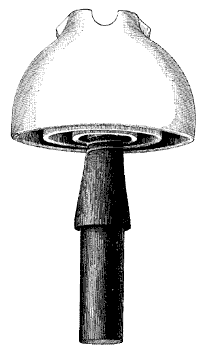[Trade Journal]
Publication: The Journal of Electricity
San Francisco, CA, United States
vol. V, no. 1, p. 27, col. 1-2
IMPERIAL PORCELAIN INSULATORS.
C. S. Knowles, of 7 Arch street, Boston, and who is general agent for the Imperial Porcelain Works, of Trenton, N. J., has issued an attractive little booklet which embodies much that was contained in the paper read by Mr. H. D. Sears before the Santa Cruz Convention of the Pacific Coast Electric Transmission Association (see IV, No. 6, page 117) and which also describes the special features of merit of the Imperial High Potential Porcelain Insulators, now being used on the Niagara-Buffalo transmission line, and which are to be used on the 33,000-volt circuit of the Southern California Power Company.
 |
The claim is boldly made that the problem of securing a high potential insulator has been solved in the use of Imperial Porcelain, in support of which the assertion is made that wherever high potential insulators have proven satisfactory they have been made of Imperial Porcelain. Wherever they have given trouble they have been of other makes.
In support of this statement, the "Electrical Engineer" of December 23, 1896, is quoted, which states that: "Reports from Niagara go to show that the power transmission to Buffalo is working very successfully. The trouble with the insulators has been eliminated since the exclusive use on the line of the 'Niagara' insulators made by the Imperial Porcelain Works."
There is also added a letter from Paul M. Lincoln, electrical superintendent of the Niagara Falls Power Company, dated January 21, last, in which he says: "The insulators which you have sent us and which have passed our test are satisfactory in every respect. We have yet to have our first trouble with them on the line. This applies to the 'Imperial' type as well as to the larger sized insulators which we are using, although the 'Imperial' type insulators were put up for only temporary use. The quality of the porcelain is much better than any other that has come under my observation. It is thoroughly vitrified and homogeneous throughout."
Continuing, the circular states: As our smallest insulators will stand the puncture test as well as the largest, the style to be used in any case is decided by the surface distance and the direct distance between tie wire and pin. The greater these distances the less liability there is to surface leakage and to the current jumping through the air. The higher the voltage used the larger, of course, should the insulators be. It is rather difficult to give the exact voltages to which our different types are adapted, as the climatic conditions have to be carefully considered. The following, however, we consider safe under all except extremely unfavorable conditions:
Imperial Nos. 3 and 4 for 5,000 volts; Imperial No. 2 for 10,000 volts; Imperial No. 1 for 15,000 volts; Redlands, type C and Niagara for higher voltages. In most cases, however, we should not hesitate to recommend Imperial No. 2 for 15,000 volts and Imperial No. 1 for 20,000 volts."
All types of Imperial insulators are "triple petticoat," and all, except "Niagara," are circular in shape. We would call special attention to this type; it is oval in shape and has a gutter on each side for the purpose of draining water clear of the crossarm. Imperial No. 3 is made with a large top groove and was designed specially for carrying electric railway feeder cables. In vertical cross section all types are of the same general design.
Messrs. John A. Roebling's Sons Co., 25-27 Fremont street, San Francisco, are Pacific Coast agents for Imperial Porcelain Insulators.
